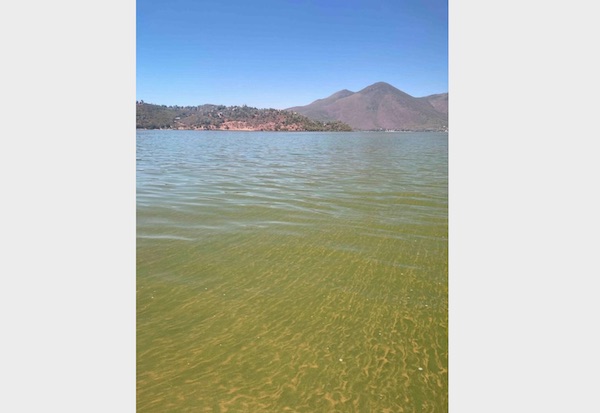State officials warn recreational water users to watch for dangerous algae

Keep family members and pets safe by learning basics of harmful algal blooms
–With the Memorial Day weekend marking the unofficial start of a busy recreational water season and as temperatures soar in many areas, the State Water Resources Control Board is once again warning the public that harmful algal blooms, or HABs, tend to flourish in the summer and can have potentially serious health impacts for humans and pets.
The State Water Board urges recreational water users to visit its HABs web portal to educate themselves about the following before engaging in activities in and around lakes and streams.
“A little bit of education about how to look for and identify toxic algae can mean the difference between a safe and enjoyable water experience and one with serious health outcomes,” said Marisa Vandyke, an environmental scientist with the State Water Board. “Children and dogs playing in the water are especially vulnerable to HABs exposure and illness. Please practice healthy water habits while outdoors this summer.”
Most harmful algal blooms are formed by cyanobacteria, small microbes that live in nearly every habitat on land and in the water. In the warmest months of summer, elevated water temperatures, slow-moving water, and excessive nutrients cause cyanobacteria to rapidly multiply and form these harmful blooms.
The drought conditions throughout California also drive the growth of these HABs in waterways with lower-than-normal water levels.
In recent weeks, the water board and its partner organizations conducted a pre-holiday assessment by gathering water samples and sharing the data from many of the state’s most visited lakes and streams with a history of HABs.
The results of the targeted sampling are summarized in an interactive map showing which sites were tested at each water body. The map also indicates the specific recreational health advisory level — Caution, Warning or Danger — based on sample testing results and/or visual presence of a HAB.
Waterways are replete with plant life, and it is important to distinguish cyanobacteria from other algae and non-toxic water plants that are not considered a concern. Harmful blooms can be a variety of colors, such as green, white, red, or brown, and may look like thick paint floating or small flakes on the water.
Not all HABs will appear on the water’s surface; some form mats at the bottom of a waterbody, and others float at various depths. Recreational water users should look closely at the bottom of a waterbody before entering the water, since algal mats are challenging to see from the shore.
The State Water Board recommends that people practice healthy water habits while enjoying the outdoors this summer at your local lake, river or stream:
- Heed all instructions on posted advisories if present
- Avoid algae and scum in the water and on the shore
- Keep an eye on children and pets
- If you think a harmful algal bloom is present, do not let pets and other animals go into or drink the water or eat scum/algal accumulations on the shore
- Don’t drink the water or use it for cooking
- Wash yourself, your family, and your pets with clean water after water play
- If you catch fish, throw away guts and clean fillets with tap water or bottled water before cooking
- Avoid eating shellfish if you think a harmful algal bloom is present
Cyanobacteria are capable of producing toxins, which have the potential to harm the environment, people, pets, wildlife, or livestock. Dogs and children are most likely to be affected because of their smaller body size, increased potential to swallow water while swimming, and tendency to stay in the water longer. Recreational exposure to cyanobacteria and associated toxins can cause eye irritation, skin rash, mouth ulcers, vomiting, diarrhea, and cold and flu-like symptoms.
Dogs are susceptible because they tend to drink while in the water and lick their fur afterward, increasing their risk of exposure and illness. Symptoms with animals include vomiting or diarrhea, lethargy, abnormal liver function test results, difficulty breathing, foaming at the mouth, muscle twitching, and sometimes death. A quick fact sheet is available to help inform dog owners at: (https://oehha.ca.gov/media/downloads/risk-assessment/fact-sheet/dogownerfactsheet2018.pdf).
Get medical treatment immediately if you think that you, your pet, or livestock has gotten sick after going in the water. Be sure to alert the medical professional to the possible contact with cyanobacteria. Also, make sure to contact the local county public health department. To report a bloom, do one of the following:
- Fill out the Bloom Report form on the portal
- Email: CyanoHAB.reports@waterboards.ca.gov
- Call the HABs hotline: 1-844-729-6466 (toll-free)
For more information about HABs, visit: https://mywaterquality.ca.gov/habs/index.html.





















